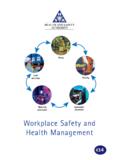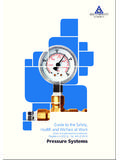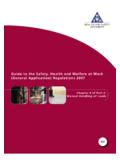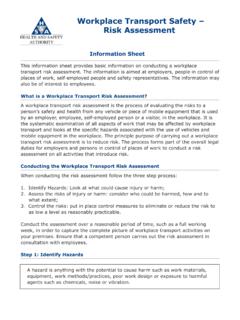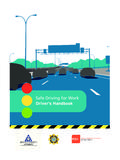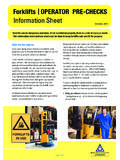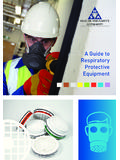Transcription of BEHAVIOUR BASED SAFETY GUIDE BETTER, SMARTER, SAFER
1 BEHAVIOUR BASEDSAFETY GUIDEDOING WHAT WE DOBETTER, SMARTER, SAFEROur vision: A country where worker SAFETY , health and welfareand the safe management of chemicals are centralto successful enterpriseMore and more we need to look at newapproaches to achieving safe and healthyworkplaces. We need to apply the learningfrom the many years of analyses of accidentsand ill health because this will contribute tofuture prevention strategies and BASED SAFETY (BBS) is an approachthat we believe can be applied successfully; itis gaining more interest across industry sectorsglobally and has the great advantage ofneeding the involvement of the individualemployee, in addition of course, to employercommitment.
2 How often have we experienced situations inwhich an employee s competence in a workprocess is assessed at the point that they leavethe training room with the assumption that,once learned, the process will be appliedcorrectly and safely? This fails to take account of the many factorsthat influence and reinforce learning andbehaviours. BBS addresses these factors. It isclosely linked to company culture and valuesand, most importantly, when it works, it is anexcellent tool to improve SAFETY performance inthe developing this GUIDE we have beenprivileged to have worked with a group ofpeople from companies that are committed tothe principles of BBS and on whom we cancount to promote the message.
3 We hope thatmany more employers and employees becomeinterested in the potential of the approaches setout and that we have added another useful andpractical tool for improving SAFETY and thanks go to all who have been ofassistance, provided insights and shared theirconsiderable expertise to help in thedevelopment of the DorganAssistant Chief ExecutiveHealth and SAFETY Authority ForewordIntroduction ..2 What is a BEHAVIOUR BASED SAFETY (BBS) approach? ..3 Reinforcement ..5 Reinforcement and Feedback ..7 Goal Setting and Feedback ..8 What is Involved in a BBS Programme?
4 9 Leadership influence ..12 Tips for successfully implementing a BBS programme in your workplace ..14 Case study ..15 Additions ..17 References ..18 Published in 2013 by the Health and SAFETY Authority, The Metropolitan Building, James Joyce Street, Dublin 1. CONTENTSB ehaviour BASED SAFETY GuideIntroductionVarious approaches have had reasonable successin reducing unsafe behaviours in the involve penalties; others involvesurveillance; others involve guidance, codes andprocedures to follow; others still are supportive andtraining-oriented. Some initiatives come from the employer, from thesocial partner organisations, from state regulatorybodies, and some worthwhile initiatives come fromindividual employees own insights, ideas, trainingand development activities around health andsafety.
5 Most employers and employees in the area ofsafety will agree that the ultimate aim of a safetyinitiative is a total SAFETY culture ; however, thisconcept is rarely defined. A total SAFETY culture is aculture in which:a) individuals hold SAFETY as a value and not just a priority;b) individuals take responsibility for the safetyof their co-workers in addition to themselves; andc) all level of employee are willing and able to act on their sense of responsibility they can go beyond the call of duty (Perdue, 2000).The following are some requirements for anyapproach to SAFETY at work that brings aboutnoticeable, lasting results and contributes to a totalsafety culture:1.
6 A strong management commitment towardsmaintaining and improving behavioural SAFETY ,witnessed in the regular acts of individuals atmanagement Respectful, trusting, open communicationbetween management and employee groupsabout all aspects of SAFETY in the An open, feedback-rich culture amongemployees, which enables employees toconsistently learn and grow. 4. A commitment to improving the profile of andattitude to health and SAFETY , and increasedemployee engagement in SAFETY . 5. An emphasis on safe and unsafe BEHAVIOUR ;not a sole dependence on lagging indicatorssuch as SAFETY statistics.
7 6. A strong, consistent, timely reaction to thediscovery of unsafe acts, whether they result ininjury or not. SAFETY incidents are viewed as anopportunity to learn and improve. 7. Generally transparent and fair leadership fromall, including managers, supervisors, Awareness amongst all staff of different waysto consider or query human factors how wedo what we do, and is a BEHAVIOUR - BASED SAFETY (BBS) approach? This GUIDE is informed by the field of BEHAVIOUR - BASED SAFETY (BBS), which is often described as a bottom-up approach (frontline employees),with top-down support from SAFETY leaders.
8 A BEHAVIOUR - BASED SAFETY approach promotesinterventions that are people-focused and oftenincorporate one-to-one or group observations ofemployees performing routine work tasks, settinggoals carefully and giving timely feedback onsafety-related BEHAVIOUR , coaching and initiatives have a proactive focus, encouragingindividuals and their work groups to consider thepotential for incident involvement, (accidents) andto assess their own BEHAVIOUR as safe or unsafealways, no matter what. A BBS approach is one which: Is BASED on solid principles about engaging,motivating, assisting, reinforcing, andsustaining safe behaviours.
9 Takes a systematic approach, examining themotivation underlying behaviours, in order toincrease safe BEHAVIOUR . Is an ongoing effort; not once-off provisions,but a new way of working that the SAFETY leadermust continually promote for sustainable,positive results. Takes time to achieve; however, results can beobserved immediately due to the nature ofmeasurement involved. Emphasises increasing safe behaviours ratherthan focusing on length of time without programmes do not depend solely on lagging indicators (after the fact), and insteadshift the focus to leading indicators (preventative).
10 Is not a substitute for an already existingcomprehensive health and SAFETY programme; it is a supplementary tool that will enhance theeffect of already existing practices, and willallow for an objective measurement system. Aims to understand causes of incidents andnear misses and correct them through thebehaviour of relevant people. For example,reducing hazards often requires behaviourchange of managers and frontline workers, and equipment redesign involves behaviourchange of engineers. BBS is about everyone s BEHAVIOUR , not justthe frontline (Agnew & Ashworth, 2012)BBS stems from the field of organisationalbehaviour analysis.


